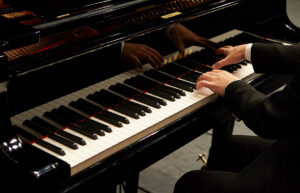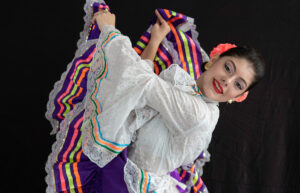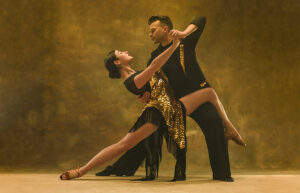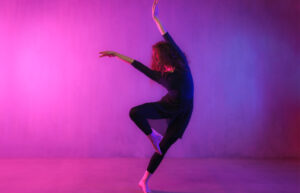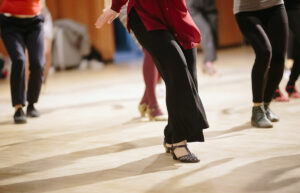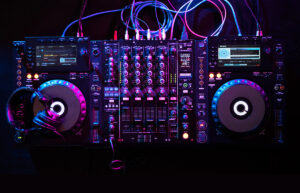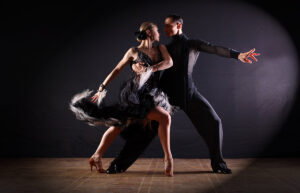How To Become A Backup Dancer: Meaning, Steps, Income & More

Embarking on a journey as a backup dancer is an exhilarating venture marked by rhythm, passion, and dedication. The satisfaction of supporting a lead artist through the art of movement is commendable. This step-by-step guide serves as your roadmap to mastering the dance floor, providing insights into the secrets, techniques, and essential steps that lead to a captivating career as a backup dancer. It offers valuable insights and a step-by-step roadmap on how to become a dancer who leaves an indelible mark on the stage
Welcome to TheDemoStop, now join the community!
Connect with artists, fans and producers around the world.
Who is a backup dancer?
A backup dancer is a talented and adaptable performer who assists the lead artist, usually a singer or musician, in live shows, music videos, and other entertainment productions. They contribute to the overall visual appeal by performing synchronized choreography that complements the lead artist, bringing energy, precision, and creativity to the stage for an enhanced entertainment experience.
What does a backup dancer do?
A backup dancer is crucial to a live performance or entertainment production, supporting the lead artist or main performer. Here’s what a backup dancer typically does:
- Learn and execute choreography: Backup dancers master and perform choreographed routines. They must be adept at learning new choreography quickly and executing it precisely.
- Support the lead performer: The primary role is to enhance the lead artist’s performance by providing visual appeal and dynamic movement by complementing the lead performer’s style and stage presence.
- Collaborate with choreographers: Backup dancers work closely with choreographers to bring their creative vision to life. This collaboration includes understanding and interpreting choreography, providing input, and adapting to routine changes.
- Perform in various settings: Backup dancers may be involved in music videos, live concerts, award shows, television performances, and other entertainment productions, showcasing their skills in diverse contexts.
- Adapt to different artists and genres: Backup dancers often work with various artists and may need to adapt their style to suit different genres of music and performance preferences.
How do you become a backup dancer?
Complete training
Start by enrolling in dance classes to build a strong foundation. Focus on different styles, such as hip-hop, jazz, ballet, or contemporary, depending on the genre you want to specialize in. Take classes regularly to improve your technique, flexibility, and techniques. Hiring a personal trainer to work on your fitness and strength is helpful, as backup dancing can be physically demanding.
Improve performance skills
Being a backup dancer involves executing dance moves, stage presence, and performance skills. Work on your facial expressions, body language, and the ability to convey emotions through your movements. Practice dancing in front of a mirror to enhance your self-awareness and stage presence.
Audition
Attend auditions for dance opportunities in your area or submit videos showcasing your skills. Look for auditions for backup dancers in music videos, live performances, or tours. Be prepared to learn choreography quickly and adapt to different styles. Confidence and a positive attitude are key during auditions.
Consider getting a degree
While not mandatory, pursuing a dance or performing arts degree can provide a more comprehensive education. Many successful backup dancers have a background in dance or related fields. Additionally, a degree can open doors to networking opportunities and connections within the industry.
Continue learning
The dance industry constantly evolves, so staying updated on the latest trends and styles is essential. Take workshops, attend dance conventions, and learn from experienced choreographers. Networking with other dancers, choreographers, and industry professionals can also increase opportunities.
Steps to becoming a good backup dancer
Step 1: Getting dance and performance experience
- Take a wide variety of dance classes: Enroll in classes that cover different dance styles to build a versatile skill set, including hip-hop, jazz, ballet, or contemporary.
- Cross-training to increase skills: Engage in activities like strength training or yoga to enhance overall physical fitness and complement dance techniques.
- Practice learning dance routines quickly for auditions: Develop the ability to pick up choreography swiftly, a crucial skill in the audition process.
- Get experience to prepare for backup dancing: Participate in local performances, dance recitals, or community events to gain valuable stage experience.
Step 2: Finding auditions
- Create your dance resume: Compile a resume detailing your dance training, performances, and any relevant experience.
- Take professional-looking headshots: Invest in high-quality headshots that showcase your personality and professionalism.
- Get an agent to help discover opportunities: Consider hiring a dance agent who can connect you with auditions and opportunities within the industry.
- Attend both open calls and private auditions: Explore various audition avenues, including open calls and private auditions, to increase your chances of finding opportunities.
- Consider relocating to a larger city to get more dance opportunities: Moving to a city with a thriving entertainment industry can provide more exposure to auditions and gigs.
Step 3: Landing dance gigs
- Arrive to the audition timely and prepared: Demonstrate professionalism by arriving punctually and being well-prepared for auditions.
- Show confidence through body language in auditions: Convey confidence through your posture, expressions, and overall body language during the audition.
- Make an impression with unique dance moves: Stand out by incorporating unique and memorable dance moves into your audition, showcasing your style.
- Put your 100% effort and energy into the audition: Give your absolute 100% best during auditions, demonstrating dedication, energy, and passion for your craft.
Step 4: Expanding your network
- Befriend other dancers to learn about auditions: Build relationships with fellow dancers to stay informed about upcoming auditions and industry insights.
- Attend dance classes at other dance studios or cities for exposure: Expand your network by attending classes in different towns or studios, increasing your visibility within the dance community.
- Create a social media page to promote yourself: Establish an online presence to showcase your skills and connect with industry professionals.
- Post your dance videos to exhibit your skills: Share dance videos on your social media platforms to highlight your talent and attract attention from potential opportunities.
Welcome to TheDemoStop, now join the community!
Connect with artists, fans and producers around the world.
How much do backup dancers get paid?
Backup dancers in the US make an average of $37,517 a year. The range of salaries is usually $30,924 to $46,504. Pay ranges can differ based on important factors, such as education, certifications, extra skills, and how long you’ve worked in your field.
11 secrets of backup dancers
They don’t need any dance training but need to learn constantly
Backup dancers may not necessarily have formal dance training, but they must consistently learn and improve their skills to stay competitive.
Some people will change how they look to fit in better
Some backup dancers may change their appearance or style to better blend in with the performance’s artistic vision or match the lead artist’s aesthetic.
They learn how to handle auditions so that they don’t get eliminated.
To avoid being cut during auditions, backup dancers learn to quickly adapt to different choreography and performance styles, showcasing their versatility and ability to adjust quickly.
They often have to make life-changing decisions on the road.
Being on tour can lead to significant life-altering decisions, such as relationships, career paths, and personal choices, as the demanding nature of the job can impact various aspects of their lives.
It’s not a particularly lucrative career
Despite the demanding nature of the job, backup dancing is not always a highly lucrative career. Many dancers face financial challenges and must navigate periods of instability between gigs.
They have to know how to adapt
Backup dancers need to be able to “go with the flow” and deal with last-minute changes, problems that come out of the blue, and the fast-paced nature of the entertainment business.
They’ll sometimes wear in-ear monitors on stage.
In some performances, backup dancers may wear in-ear monitors on stage to receive instructions, cues, or the music track, allowing for precise synchronization with the performance.
Two can sometimes be better than one.
Collaborative performances often benefit from the synergy of two backup dancers, emphasizing that sometimes, a pair’s collective energy and coordination can enhance the overall impact.
A dance crew can feel like family.
Even without blood relations, backup dancers often form a close-knit family-like bond due to the shared experiences, extensive time spent together during rehearsals and tours, and the industry’s unique challenges.
For decades, dancers had no union or healthcare assurances
For many decades, backup dancers faced challenges such as the absence of a union and healthcare assurances, highlighting the precarious nature of their profession.
They always have a backup plan
Given the uncertainties of the entertainment industry, backup dancers understand the importance of having alternative career plans or pursuits to fall back on during periods of instability or downtime.
Jobs that are common for backup dancers
- Music videos/film: Backup dancers are hired for music video productions and films to complement the lead artist’s performance and contribute to the visual storytelling of the project.
- Performing on tour: Many backup dancers join artists on tour, providing dynamic and visually engaging performances during live concerts by traveling to different cities or countries as part of the touring ensemble.
- Live events: Backup dancers often feature in live events, including award shows, televised performances, and special events. Their energetic performances add flair to the overall entertainment experience.
The ultimate goal of backup dancers is to become the Best Dancer in the World—an honor attained with unwavering devotion to the art and a commitment to enhancing each performance—while they strive for perfection and master the difficult art of providing precise and passionate support to lead artists.
Welcome to TheDemoStop, now join the community!
Connect with artists, fans and producers around the world.
Conclusion
What is a backup dancer?
A professional dancer who supports and enhances the main artist’s stage presence through synchronized and complementary dance movements.
What does a backup dancer do?
Backup dancers play a vital role in live performances, music videos, and entertainment productions. They support the lead artist visually by executing synchronized movements, mastering diverse choreography, and collaborating closely with choreographers to enhance performances. Maintaining a background presence, they adapt to various dance styles without overshadowing the lead artist.
How to become a backup dancer?
Engage in diverse dance classes for a strong foundation, practice to enhance performance skills, attend auditions for exposure, consider a dance or performing arts degree, and stay updated through workshops for ongoing growth in the industry.
Steps to becoming a good backup dancer
To pursue backup dancing, gain diverse dance experience through classes and cross-training. Prepare for auditions by practicing routines and creating a professional dance resume with headshots. Attend open calls and consider getting an agent. Showcase confidence and unique moves at auditions, giving your best effort to land gigs. Expand your network by befriending dancers, attending classes in different locations, and promoting your skills on social media through videos.
How much do backup dancers get paid?
The average salary of a backup Dancer salary in the United States is approximately $37,517.
11 secrets of backup dancers
- They don’t need any dance training but need to learn constantly.
- Some will change how they look to fit in better.
- They learn how to handle auditions so that they don’t get eliminated.
- They often have to make life-changing decisions on the road.
- It’s not a particularly lucrative career.
- They have to know how to adapt.
- They’ll sometimes wear in-ear monitors on stage.
- Two can sometimes be better than one.
- A dancer crew can feel like family.
- For decades, dancers had no union or healthcare assurances.
- They always have a backup plan.
Jobs that are common for backup dancers
Backup dancers commonly find employment in various entertainment sectors, such as music videos, films, live tours, and events. Their versatile skills in synchronized choreography make them essential contributors to visual performances, adding energy and creativity to the overall entertainment experience.
FAQs
What is a backup dancer?
A backup dancer is a skilled performer who supports the lead artist in live performances, music videos, and other productions, contributing dynamic movement and visual appeal to enhance the overall performance.
What does a backup dancer do?
The roles of a backup dancer are stated below:
- Learn and execute choreography
- Support the lead performer in live performances
- Collaborate with choreographers
- Adapt to different dance styles and genres
- Perform in various settings (music videos, live events, etc.)
How do you become a backup dancer?
To become a backup dancer:
- Finish the dance training
- Improve stage performance skills
- Give auditions to land gigs and improve confidence
- Consider pursuing a dance degree
- Never stop learning (workshops, masterclasses, etc.)
Is a backup dancer a good career?
Working as a backup dancer is a good career that offers a dynamic and creative environment, opportunities to work with renowned artists, and the chance to showcase one’s talent. However, it can be financially unpredictable, competitive, and physically demanding. It’s a fulfilling career for those passionate about dance and the performing arts.
How much does a backup dancer make?
The average pay range for a backup dancer in the US is $30,924 to $46,504.
What are the steps to becoming a good backup dancer?
Here are the steps to becoming a good backup dancer:
- Learn the basics: Master fundamental dance styles like hip-hop, jazz, or contemporary by enrolling in dance classes to refine your technique, timing, and coordination.
- Audition for opportunities: Attend auditions for backup dancer roles and gain experience performing under pressure.
- Landing dance gigs: Show your stage presence through facial expressions, body language, and connection with the audience.
- Networking: Connect with dancers, choreographers, and professionals in the industry to expand your opportunities.
Is networking important for aspiring backup dancers?
Networking is crucial for aspiring backup dancers as it helps them discover auditions, build connections with choreographers, and open doors to various opportunities within the competitive entertainment industry. Knowing the right people is just as important as having the right skills.
Can we work as backup dancers without an agent or dance agency?
Working as a backup dancer without an agent or dance agency is possible. Many dancers start by attending open auditions, networking within the dance community, and promoting themselves independently. However, having an agent can provide valuable industry connections and increase the chances of landing opportunities.
Are there specific organizations or associations for backup dancers?
While no exclusive organizations cater specifically to backup dancers, they may align with broader dance associations or unions like the Screen Actors Guild-American Federation of Television and Radio Artists (SAG-AFTRA) or the Actors’ Equity Association. These entities, supporting performers across entertainment sectors, offer resources, representation, and advocacy for dancers, including backup dancers.
What are the common jobs for backup dancers?
Some of the common jobs for backup dancers are:
- Music videos/films
- Touring performances
- Live events
- Television shows
- Award shows





